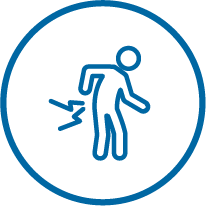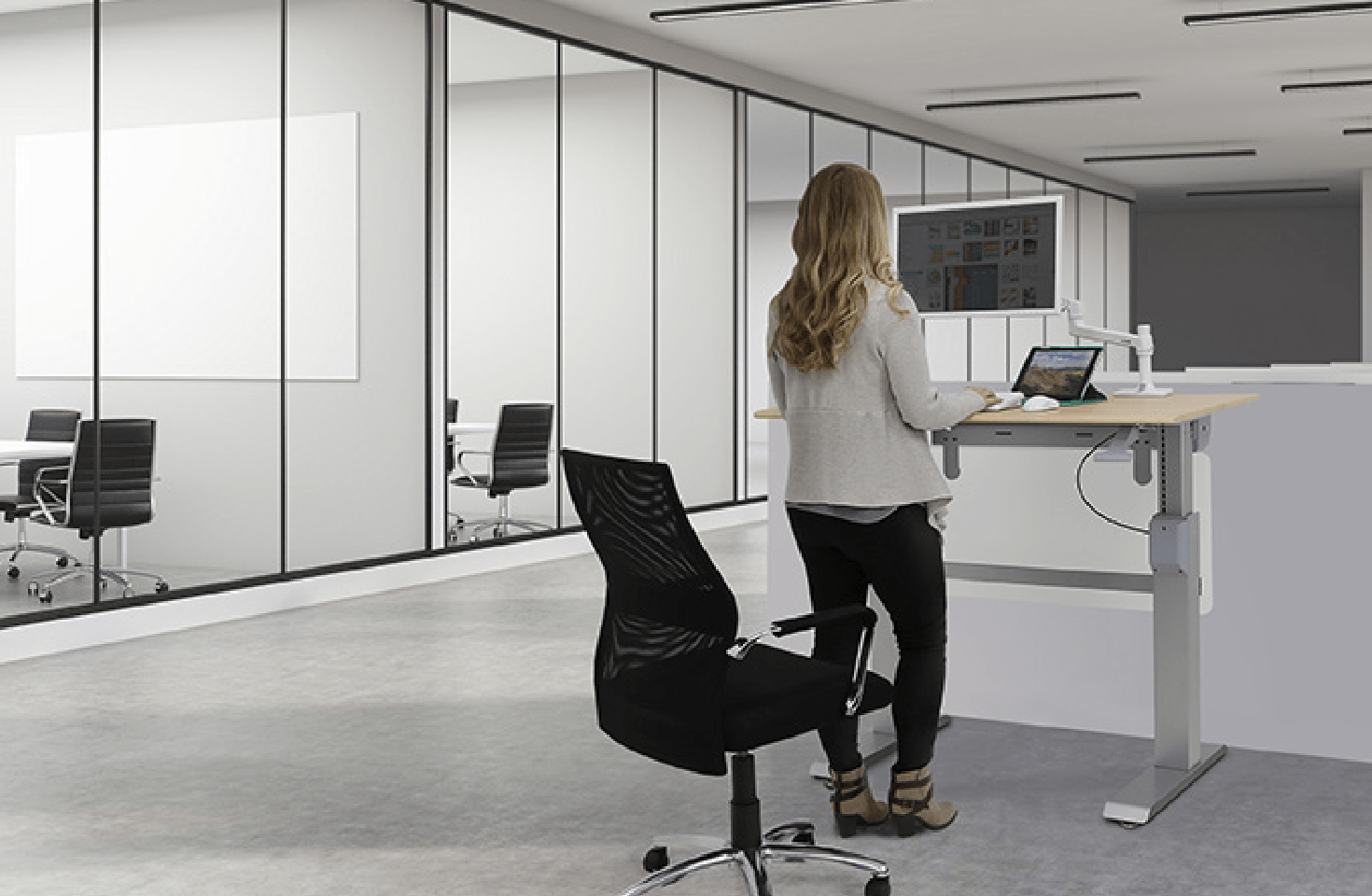
EnhanceProductivity
Employee productivity is mutually beneficial. An employee's ability to be productive throughout the day is a key factor to achieving work-life balance, while employee efficiency is the lifeblood of an organization. A movement-friendly workplace can make a big difference - it only takes 10 minutes of movement to increase mental focus.1
READ MORE

EnhanceProductivity
Employee productivity is mutually beneficial. An employee's ability to be productive throughout the day is a key factor to achieving work-life balance, while employee efficiency is the lifeblood of an organization. A movement-friendly workplace can make a big difference - it only takes 10 minutes of movement to increase mental focus.1
- In one study, employees who alternate between sitting and standing at work are more than 50 percent more productive than employees using traditional seated desks2
- Another study showed that two-thirds of employees feel more productive when they had a desk that allowed them to stand for part of the day3
- The majority of employees take two to five breaks a day to relieve the discomfort and fatigue caused by prolonged sitting4

ImproveMood and Satisfaction
Happy employees foster a more positive work environment and company culture. Today, culture is critical to talent acquisition and retention. 57 percent of job seekers say benefits and perks are among their top considerations when looking for a new job.5
READ MORE

ImproveMood and Satisfaction
Happy employees foster a more positive work environment and company culture. Today, culture is critical to talent acquisition and retention. 57 percent of job seekers say benefits and perks are among their top considerations when looking for a new job.5
- Incorporating movement has been shown to enhance employee enthusiasm and job satisfaction7
- Employees who engage in short bouts of activity (five minutes of walking every hour) throughout the day reported a better mood and lower levels of fatigue6
- Employees report improved mood states after seven weeks of using a sit-stand desk7
- 62 percent of employees said they were happier after reducing sitting time by an hour7
- Employees aren’t happy about sitting. 68 percent say they must sit all day for their job and 61 percent dislike or even hate sitting all day4

ReducePain and Discomfort
Movement-friendly workspaces – that include sit-stand workstations, ergonomic equipment or even promote activities like standing meetings – can help those in pain reduce or reverse their problems, and help those that are healthy stay that way. An added bonus of keeping employees active and healthy is reduced healthcare costs for employers.8
READ MORE

ReducePain and Discomfort
Movement-friendly workspaces – that include sit-stand workstations, ergonomic equipment or even promote activities like standing meetings – can help those in pain reduce or reverse their problems, and help those that are healthy stay that way. An added bonus of keeping employees active and healthy is reduced healthcare costs for employers.8
- Employees take two to five breaks a day to relieve the discomfort and fatigue caused by prolonged sitting4
- Workers who used sit-stand desks were 78 percent more likely to report a pain-free day than those who used regular workstations9
- Low back pain is the most common cause of job-related disability. The estimated healthcare, lost income, and productivity costs associated with low back pain are in excess of $85 billion9
- Use of a sit-stand desk reduced upper back and neck pain by 54% after just four weeks3
Whether it's standing meetings, walking paths or sit-stand workstations, employers can embrace movement in a way that has a positive impact on employee health and productivity every day."
CWWPM, CWWS, wellness market manager, Ergotron

Quick Tips
For Business Leaders
For Employees
For Human Resources
For Human Resources
- Share your vision with the executive team. Sit-stand workstations are a great way to attract and retain top talent.
- Add employee wellness to the organization’s performance reports. Sit-stand workstations are a great tool to help lower healthcare costs and improve employee productivity and engagement.
- Support changes and facility improvements that make it safer and more convenient to move before, during, and after the work day.
- Lead the culture change. Use a sit-stand workstation and conduct walking meetings. When you move, they move.
See how quickly a sit-stand workstation pays for itself – use our Ergonomic Payback Calculator.
Click HereFor Human Resources
- Practice the sit-stand switch: every 30 minutes; alternate between sitting and standing.
- Stand up when someone comes to your desk to talk about a project.
- Incorporate stretching or simple exercises into both seated and standing positions.
- Conduct standing or walking meetings with team members.
Want a sit-stand desk in your office? Download our Champion Toolkit.
Click HereFor Human Resources
- Add sit-stand workstations to your corporate wellness programming.
- Educate employees on the many perks of moving more.
- Create a standard process for ordering and installing units.
- Design programs to help employees adjust to a movement mindset.
Interested in learning how sit-stand interventions can make a difference in your office? Watch our webinar: Building a Business Case for Sit-Stand at Work.
Click HereDid You Know?
Medical associations, like the American Medical Association (AMA) recognize the risks of prolonged sitting and adopted new policy that encourage businesses to offer alternatives to sitting all day, such as standing workstations, isometric balls, and more to encourage healthier movement throughout the workday.
$150 Billion
More employee activity can have an impact on absenteeism and presenteeism as well as healthcare costs10: Absenteeism can cost employers around $150 billion per year. Presenteeism can cost employers around $1,500 billion per year.
$2,500
Employees who incorporate low-level activity throughout the day can save their companies an average of $2,500 in annual health care expenses relating to cardiovascular disease.
Enhanced Collaboration
A movement-friendly office can enhance collaboration: Sit-stand workstation users (particularly those ages 20-30) report being more likely to engage in face-time with coworkers than those using traditional sit-only workstations.7
How to Get Started
- WorkFit Champion Toolkit
- Standing Up for Workplace Wellness [white paper]
- Building A Business Case for Sit-Stand At Work [On-demand Webinar]
- Office products
- Sitting-Time Calculator
- Calorie Burn Calculator
Featured Content
- Make the Sit-Stand Switch™ [Handbook]
- Getting Productivity Up & Moving [Infographic]
- 2016 JustStand Index [eBook]
- Reducing Low Back Pain at Work [Infographic]
- Take-a-Stand Project [Infographic]
- Sit-Stand Computing [Infographic]
- The WorkFit Survey Report [Infographic]
Tools to Plan Your Space
- For a full list of references, click here.





